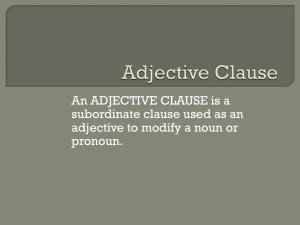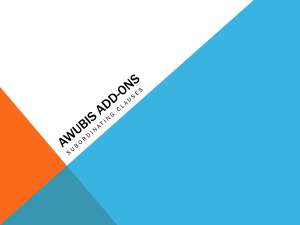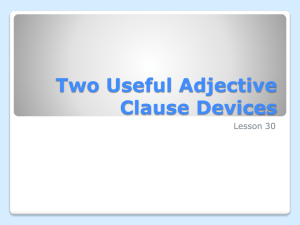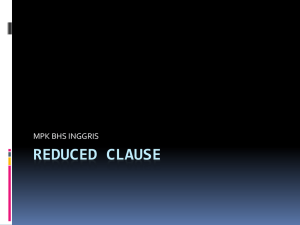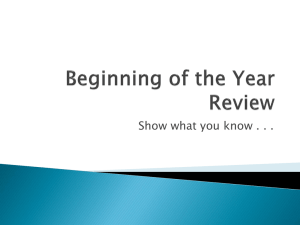Lesson 15 Variations of the Adjective Clause
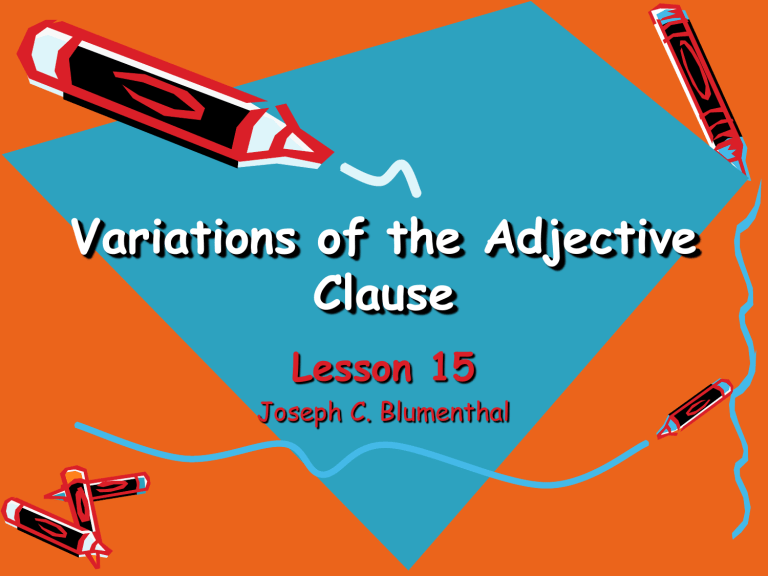
Variations of the Adjective
Clause
Lesson 15
Joseph C. Blumenthal
RELATIVE PRONOUNS: who (whose, whom), which, that
These are the relative pronouns that serve as clause signals for _______ clauses.
RELATIVE PRONOUNS: who (whose, whom), which, that
These are the relative pronouns that serve as clause signals for adjective clauses.
Only one of these sentences is a compound sentence because it can be split into two parts—each with its own subject and predicate.
a. I paid my check and waited for my change.
b. I paid my check, and the waiter brought me my change.
Which is the compound sentence?
Only one of these sentences is a compound sentence because it can be split into two parts—each with its own subject and predicate.
a. I paid my check and waited for my change.
b. I paid my check, and the waiter brought me my change.
Which is the compound sentence?
We sometimes use a preposition before the relative pronoun; for example, with which, for which, to whom. In such cases the preposition belongs to the adjective clause.
The pen with which he wrote was scratchy.
The first word of the adjective clause is ( with, which ).
We sometimes use a preposition before the relative pronoun; for example, with which, for which, to whom. In such cases the preposition belongs to the adjective clause.
The pen with which he wrote was scratchy.
The first word of the adjective clause is ( with, which ).
The pen with (which he wrote) was scratchy.
The pen (with which he wrote) was scratchy.
Read the sentence, omitting the words in parentheses. If the remaining words are a sentence, the clause was correctly selected.
The preposition with ( is, is not ) part of the clause.
The pen with (which he wrote) was scratchy.
The pen ( with which he wrote ) was scratchy.
Read the sentence, omitting the words in parentheses. If the remaining words are a sentence, the clause was correctly selected.
The preposition with ( is, is not ) part of the clause.
The man for whom Matthew Henson worked urged him to get an education.
The first word of the adjective clause is
( whom, for ).
The man for whom Matthew Henson worked urged him to get an education.
The first word of the adjective clause is
( whom, for ).
The man for whom Matthew Henson worked urged him to get an education.
The adjective clause begins with the preposition for and ends with the word
_____.
The man for whom Matthew Henson worked urged him to get an education.
The adjective clause begins with the preposition for and ends with the word worked .
The bottle in which the lotion comes costs more than the lotion.
Is the preposition in part of the adjective clause? ( yes, no )
The bottle in which the lotion comes costs more than the lotion.
Is the preposition in part of the adjective clause? ( yes, no )
The bottle in which the lotion comes costs more than the lotion.
The bottle…costs more than the lotion.
When we omit the adjective clause, do we have a complete sentence remaining? ( yes, no )
The bottle in which the lotion comes costs more than the lotion.
The bottle…costs more than the lotion.
When we omit the adjective clause, do we have a complete sentence remaining? ( yes, no )
a. The things (at which the audience laughed) were very silly.
b. The things at (which the audience laughed) were very silly.
In which sentence is the clause correctly identified? ( a, b )
a. The things (at which the audience laughed) were very silly.
b. The things at (which the audience laughed) were very silly.
In which sentence is the clause correctly identified? ( a, b )
a. We were eager to try the dishes
which have made this inn famous.
b. We were eager to try the dishes for which this in is famous.
In which sentence does the preposition precede the relative pronoun which signals the clause? (a, b)
a. We were eager to try the dishes
which have made this inn famous.
b. We were eager to try the dishes for which this in is famous.
In which sentence does the preposition precede the relative pronoun which signals the clause? (a, b )
The conditions…which we played were difficult.
The adjective clause in this sentence requires a preposition. Choose the preposition that would make the best sense.
by under at with
The conditions…which we played were difficult.
The adjective clause in this sentence requires a preposition. Choose the preposition that would make the best sense.
by under at with
The conditions under which we played were difficult.
The adjective clause begins with the preposition under and ends with the word _____.
The conditions under which we played were difficult.
The adjective clause begins with the preposition under and ends with the word played .
Although relative pronouns are usually a signal that an adjective clause is starting, the relative pronoun is sometimes omitted.
Most of the things (that) we fear never happen.
Can the clause signal be omitted in the above sentence? (yes, no)
Although relative pronouns are usually a signal that an adjective clause is starting, the relative pronoun is sometimes omitted.
Most of the things (that) we fear never happen.
Can the clause signal be omitted in the above sentence? ( yes , no)
We can learn to recognize these “no signal” clauses if we watch for a subject-verb combination right after a noun.
Most of the things we fear never happen.
Here we have a subject-verb combination right after the noun _____.
We can learn to recognize these “no signal” clauses if we watch for a subject-verb combination right after a noun.
Most of the things we fear never happen.
Here we have a subject-verb combination right after the noun things .
Most of the things we fear never happen.
The subject of the adjective clause is
____, and the verb is ____.
Most of the things we fear never happen.
The subject of the adjective clause is
_ we _, and the verb is _ fear _.
A good test for a “no signal” adjective clause is to see whether we can insert a relative pronoun before it.
Sue described the kind of boat she expects to build.
Can we insert which or that before the word she? ( yes, no )
A good test for a “no signal” adjective clause is to see whether we can insert a relative pronoun before it.
that
Sue described the kind of boat she expects to build.
Can we insert which or that before the word she? ( yes, no )
Sue described the kind of boat she expects to build.
The adjective clause begins with the word _____ and ends with the word
_____.
Sue described the kind of boat she expects to build .
The adjective clause begins with the word _ she _ and ends with the word
_ build _.
People are known by the company they keep.
We could insert the clause signal which or that before the word _____.
People are known by the company they keep.
We could insert the clause signal which or that before the word _ they _.
People are known by the company they keep.
The “no signal” clause in this sentence consists of two words: _____ _____.
People are known by the company they keep.
The “no signal” clause in this sentence consists of two words: _ they _ _ keep _.
The drawer was full of things nobody would ever want.
We could insert the clause signal which or that before the word _____.
The drawer was full of things nobody would ever want.
We could insert the clause signal which or that before the word nobody .
The drawer was full of things nobody would ever want.
The “no signal” adjective clause begins with the word _____ and ends with the word _____.
The drawer was full of things nobody would ever want .
The “no signal” adjective clause begins with the word nobody and ends with the word want .
Write the following answers on your own sheet of paper.
Now let’s review some of the things we have learned about adjectives clauses in this and the previous lesson. a. An adjective clause is one that does the work of a single adjective.
b. An adjective clause is one that begins with an adjective.
1. Which definition of an adjective clause is correct? ( a, b )
2. An adjective clause, like an adjective, modifies a ____ or a pronoun.
3. An adjective clause always comes
( before, after ) the word it modifies.
4. If a clause can be shifted from one position to another in a sentence, it is an ( adjective, adverb ) clause.
5. The adjective clause signal who
(whose, whom), which, and that are called relative ( adjectives, pronouns ).
6. When we omit an adjective clause from a sentence, a grammatically
( complete, incomplete ) sentence remains.
7. Is a relative pronoun such as who, which, or that always the first word in an adjective clause? ( yes, no )
We called a doctor whom a neighbor had recommend.
We called a doctor a neighbor had recommended.
8. Does an adjective clause always contain a relative pronoun? ( yes, no )
